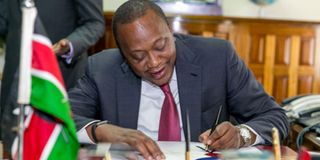Does mining have a seat at Jubilee Big Four table?

President Uhuru Kenyatta. FILE PHOTO | NMG
What you need to know:
- Mining’s GDP contribution has stuck stubbornly around 1 per cent since 2013, while Kenya’s transition to an oil producer by 2022 is a much more exciting story with a potential GDP contribution of 5 per cent.
- Additionally, the much-touted huge mineral potential is yet to be established while oil resource estimates have been defined.
- The Mining ministry produced a mixed bag of results. The first phase, 2013 – 2015, was extremely disruptive and contributed to a rapid decline in investor confidence at a time when commodity prices were enduring a bear run.
Kenya’s standalone ministry of Mining is no more. As is common in many jurisdictions, the Petroleum and Mining portfolios have been combined. They have obvious commonalities including access to land, community concerns, regulatory regimes, long project lead times, macroeconomic and environmental impact.
Mining’s GDP contribution has stuck stubbornly around 1 per cent since 2013, while Kenya’s transition to an oil producer by 2022 is a much more exciting story with a potential GDP contribution of 5 per cent. Additionally, the much-touted huge mineral potential is yet to be established while oil resource estimates have been defined.
The Mining ministry produced a mixed bag of results. The first phase, 2013 – 2015, was extremely disruptive and contributed to a rapid decline in investor confidence at a time when commodity prices were enduring a bear run.
This culminated in Kenya’s international standing hitting an all-time low in 2014 as reported by the much publicised Fraser Institute Survey of Mining Companies. The second phase, 2015 – 2017, was a welcome relief, resulting in the Mining Act 2016 and other achievements, which improved our global ranking.
However, momentum as measured by investment ran out of steam. The current phase will determine whether the industry finally realises its potential or remains in the shadow of petroleum. The State Department of Mining should heed the warning signs and quickly anchor itself to President Kenyatta’s Big 4 Plan. The Treasury’s recent Budget Policy Statement lists exploration and investor friendly policy formulation as key sector priorities. Instructively, it sets a target of attracting one international investor in mining value addition by 2022.
Regulatory framework
As the statement proposes, policy and regulatory frameworks that support mining at all levels including artisanal and small scale mining (ASM) will need refinement. Mining as a sustainable economic activity needs legal certainty, ethical practices and profitability. The only uncertain variables should be geology and commodity pricing.
The good news is that we are nearly there – a key plank is the new mining regulations that need to be approved by Parliament and implemented.
Of utmost importance will be attracting investment, both foreign and local. This is the ultimate measure of success if mining is to contribute to the Big 4 agenda. Simply put, we need to see increased mineral output from existing and new mines.
As has been argued before, Kenyans have the capacity to contribute significantly to developing our own minerals, in partnership with credible international players. The Mining Act proposes a National Mining Corporation (NMC). The Cabinet secretary should move with speed to establish the entity as an active investment vehicle. Rather than competing for space in the industry, the NMC should seek technical and financial partnerships concentrating on identifying and commercialising new and known deposits.
A good place to start would be the small scale miners who lack the capacity to pump up their operations. The NMC should be the proverbial one-stop shop helping new entrants navigate the mining space, including assisting with the licensing process, community relations and generally safeguarding investment.
It remains uncertain whether the much touted air-borne geo-physical survey should remain a portfolio priority. While the survey would be useful, the cost appears prohibitive and its continued delay is sending the wrong “wait and see” signal to potential investors.
The survey can remain on the cards but with a longer time frame. Investors such as Base Titanium and Acacia Mining have already demonstrated that in the right environment private capital can fund mineral exploration.
We can continue to pursue the grand schemes of the past five years but I suspect the President will demand concrete results in support of the Big 4 plan. Let us get back to basics and we just might realise that potential.
The writer is the managing director and head of energy and natural resources at Standard and Mutual.




